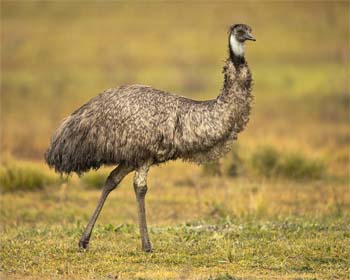The emu (/ˈiːmjuː/; Dromaius novaehollandiae) is a species of flightless bird endemic to Australia, where it is the tallest native bird. It is the only extant member of the genus Dromaius and the third-tallest living bird after its African ratite relatives, the common ostrich and Somali ostrich. The emu's native ranges cover most of the Australian mainland. The Tasmanian, Kangaroo Island and King Island subspecies became extinct after the European settlement of Australia in 1788.
Emus have soft, brown feathers with long necks and legs, and can reach up to 1.9 m (6 ft 3 in) in height. They are robust bipedal runners that can travel great distances, and when necessary can sprint at 48 km/h (30 mph). They are omnivorous and forage on a variety of plants and insects, and can go for weeks without eating. They drink infrequently, but take in copious amounts of fresh water when the opportunity arises.
Breeding takes place in May and June, and fighting among females for a mate is common. Females can mate several times and lay several clutches of eggs in one season. The male does the incubation; during this process he hardly eats or drinks and loses a significant amount of weight. The eggs hatch after around eight weeks, and the young are nurtured by their fathers. They reach full size after around six months, but can remain as a family unit until the next breeding season.
The bird is sufficiently common for it to be rated as a least-concern species by the International Union for Conservation of Nature. Despite this, some local populations are listed as endangered, with all the insular subspecies going extinct by the 1800s. Threats to their survival include egg predation by other animals (especially invasive species), roadkills and habitat fragmentation.
The emu is an important cultural icon of Australia, appearing on the coat of arms and various coinages. The bird features prominently in Indigenous Australian mythologies.
